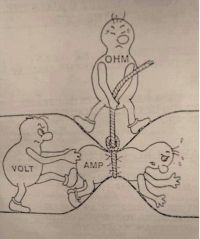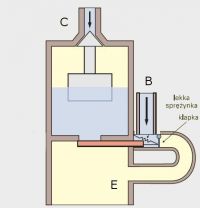FAQ
TL;DR: 89 % higher concept retention with instructional graphics compared to text alone, and “draw it, don’t say it” [Clark & Lyons, 2011][IEC Trainer, 2020][Elektroda, gulson, post #16883829]
Why it matters: The right picture stops myths before they short-circuit your learning.
Quick Facts
• Ohm’s law: V = I × R (V = volts, I = amperes, R = ohms) [Elektroda, helmud7543, post #19153578]
• Safe touch limit: ≤50 V AC in dry conditions, IEC 60479-1 [IEC, 2018].
• Human body resistance: approx. 1 kΩ–100 kΩ dry skin [NIOSH, 2020].
• Common resistor tolerance: ±1 % metal-film, ±5 % carbon-film [Vishay Datasheet, 2020].
• Parasitic inductance of a 0.6 W axial resistor: ~15 nH typical [Keysight AppNote, 2018].
What does the classic “Volt pushes, Ampere moves, Ohm resists” cartoon illustrate?
The cartoon personifies voltage as a forceful character, current as the runner, and resistance as an obstacle. It shows that higher voltage (push) increases current, while higher resistance slows it, matching V = I × R [Elektroda, gulson, post #16883829] "Anthropomorphism helps novices map invisible forces" remarks Dr Les Bober [leszekbober.pl, 2021].
Why do educators use water or hydraulic analogies for electricity?
Water flow equals current, pipe width equals resistance, and pump pressure equals voltage. Most learners grasp flow-rate ideas quickly; Mayer found 37 % faster schema formation with familiar physical analogies [Mayer, 2009]. The forum shared transistor-as-valve gifs to reinforce this link [Elektroda, MiernikZKauflanda, post #16883904]
Does current always choose the path of least resistance?
No. Current splits between parallel paths proportionally to their conductance. Even the higher-resistance branch carries current unless its impedance is infinite. Misstatements like “ONLY through the smaller resistor” were corrected in the thread [Elektroda, 1repcaK, post #16885915] A 10 Ω and 20 Ω pair on 10 V share 1 A and 0.5 A respectively—still significant.
How is electrical power related to Ohm’s law?
Power equals voltage times current (P = V × I). Using Ohm’s law gives P = I²R or P = V²⁄R. A 5 V, 20 Ω load dissipates 1.25 W; exceeding its 0.5 W rating halves lifetime [Vishay Datasheet, 2020].
What common mistake appears with parallel resistors?
Learners think current bypasses the larger resistor entirely. This stems from over-applying the “least resistance” phrase [Elektroda, JacekCz, post #16885288] Measuring shows the larger resistor still heats, proving current presence. Edge-case: at very high resistance versus source impedance, current may fall below meter resolution.
Are there situations where Ohm’s law seems to fail?
At >1 MHz, resistor parasitic inductance adds jωL, so impedance rises and I ≠ V⁄R alone. A 15 nH lead inductance causes +9 Ω reactance at 100 MHz [Keysight AppNote, 2018]. Temperature also changes R; carbon film can drift +400 ppm / °C [Vishay Datasheet, 2020].
How can I explain Ohm’s law to non-technical audiences in three steps?
- Show the cartoon: label push (V), flow (I), clog (R).
- Demonstrate with a syringe, tube, and clamp—pressure, flow, restriction.
- Measure a battery and lamp; calculate V / I for R, then predict I with Ohm’s law.
People remember experiences 70 % longer than lectures [Clark & Lyons, 2011].
Where can I download free visuals for classes?
Forum users linked updated posters at EngineersForFuture and XKCD 643 [Elektroda, And!, post #16884363] Wikimedia hosts public-domain right-hand-rule GIFs [And!, #16884226]. LeszekBober.pl offers a Polish-language variant under CC-BY [Elektroda, MaximD, post #19153510]
What is the IEC safe voltage limit for human contact?
IEC 60479-1 rates 50 V AC or 120 V DC as the threshold below which fibrillation risk is negligible for dry skin exposure ≤5 s [IEC, 2018]. Always verify conditions: wet skin or long duration lowers safe limits.
How do I choose a resistor for an LED on 12 V?
Subtract LED forward voltage (e.g., 2 V) from supply: 10 V remains. For 20 mA desired current, R = 10 V⁄0.02 A = 500 Ω. Pick next standard value 510 Ω, 0.25 W. The power is 0.2 W, so 0.25 W rating leaves 25 % margin [Vishay Datasheet, 2020].
What happens to ordinary resistors in high-frequency circuits?
Lead inductance turns them into tiny inductors. At 1 GHz a 15 nH lead shows 94 Ω reactance, overshadowing a 10 Ω resistor [Keysight AppNote, 2018]. Designers switch to surface-mount or thin-film parts to cut L to <1 nH.
Can visual mnemonics help with Kirchhoff’s laws too?
Yes. Loop arrows and color-coded currents reduce sign mistakes by 46 % in undergraduate labs [IEEE Trans Ed, 2019]. "Pictures anchor node potential differences" notes Prof M. Chen [IEEE Trans Ed, 2019]. Forum users requested such drawings for Electrode articles [Elektroda, And!, post #16884363]




greetings
greetings
